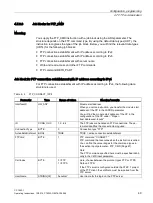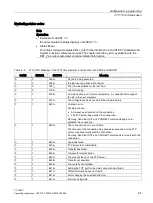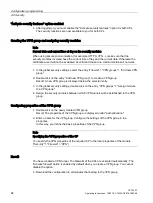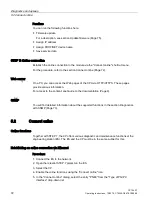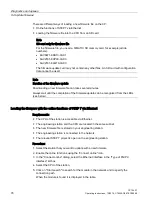
Configuration, programming
4.8 Security
CP 1543-1
Operating Instructions, 12/2019, C79000-G8976-C289-08
61
4.8
Security
You will find an overview of the range and use of the security functions in section Industrial
Ethernet Security (Page 14).
For the configuration limits of the security functions refer to the section Characteristics
security (Page 18).
To be able to configure the security functions, you need to create a security user; see
section Security user (Page 61).
4.8.1
Security user
Creating a security user
You need the relevant configuration rights to be able to configure security functions. For this
purpose, you need to create at least one security user with the corresponding rights.
Navigate to the global security settings > "User and roles" > "Users" tab.
1.
Create a user and configure the parameters.
2.
Assign this user the role "NET Standard" or "NET Administrator" in the area below
"Assigned roles".
After logging on, this user can make the necessary settings in the STEP 7 project.
In the future, continue to log on as this user when working on security parameters.
4.8.2
VPN
The "VPN" parameter group of the module is only displayed when you assign the module to
a VPN group in the global security functions.
What is VPN?
Virtual Private Network (VPN) is a technology for secure transportation of confidential data in
public IP networks, for example the Internet. With VPN, a secure connection (= tunnel) is set
up and operated between two secure IT systems or networks via a non-secure network.
One of the main characteristics of the VPN tunnel is that it forwards all network packets
regardless of higher protocols (HTTP, FTP).
The data traffic between two network components is transported practically unrestricted
through another network. This allows entire networks to be connected together via a
neighboring network.
Properties
●
VPN forms a logical subnet that is embedded in a neighboring (assigned) network. VPN
uses the usual addressing mechanisms of the assigned network, however in terms of the



